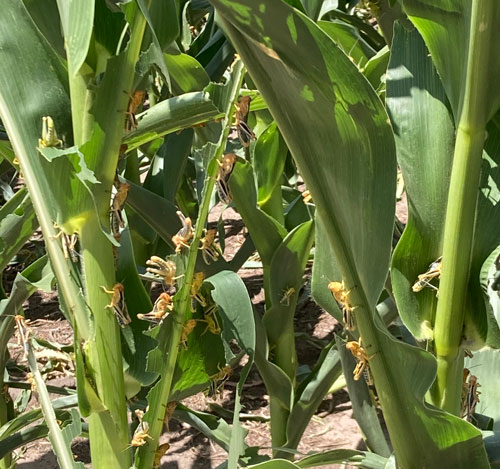Weather patterns can have a significant impact on grasshopper populations year to year. Hot, dry summers increase the survival of nymphs and adult grasshoppers, leading to increased egg production during the growing season. Cool, wet weather promotes fungal pathogens that can reduce egg and nymph survival, but if the following spring is warm and wet, egg hatching will increase, and more nymphs survive. So, several years of hot, dry summers followed by warm, wet springs can eventually lead to large populations of grasshoppers in some regions.
Weather patterns, along with abundant grassy and broad-leaf weeds, have supported the presence of large grasshopper populations in western and central Kansas this year (Figure 1). Most crops are likely mature enough to withstand some defoliation as summer continues. However, 5 to 8 grasshoppers per square yard in corn or sorghum fields may warrant treatment.

Figure 1. Grasshopper infestation in corn. Photo by C. Nisly.
Fall-planted crops: Alfalfa and wheat
Later this season, fall-planted crops could be at risk, especially as alternate food sources are controlled or go dormant. In areas with larger grasshopper populations, seedling alfalfa and wheat could be at risk.
Before planting alfalfa, treatment should be considered if there are 15 or more grasshoppers per square yard around the planting area. Once planted and growing, consider treatment if 3-5 grasshoppers per square yard are found in the seedling alfalfa stand.
Vegetated borders around areas where wheat will be planted should be scouted 10 days before planting. Consider treating those borders if there are 7 to 12 grasshoppers per square yard. Once growing, 3 or more grasshoppers per square yard within the field can destroy seedling wheat stands. If grasshopper populations are low to moderate, seed treatments can protect emerging wheat plants for several weeks if products are applied at the highest registered rate. Seed treatments will be less effective under severe grasshopper pressure. Avoid planting too early, as this will help reduce the time that wheat will need to be protected.
In either crop, multiple applications might be necessary depending on the products used and the severity of the season’s grasshopper buildup. Please refer to the most recent Insect Management Guides for specific control information.
Corn Insect Management Guide: https://bookstore.ksre.ksu.edu/download/corn-insect-pest-management-2024_MF810
Sorghum Insect Management Guide: https://bookstore.ksre.ksu.edu/pubs/sorghum-insect-pest-management-2024_MF742.pdf
Alfalfa Insect Management Guide: https://bookstore.ksre.ksu.edu/pubs/alfalfa-insect-pest-management-2024_MF809.PDF
Wheat Insect Management Guide: https://bookstore.ksre.ksu.edu/pubs/wheat-insect-pest-management-2024_MF745.pdf
Anthony Zukoff, Extension Entomology Associate – Garden City
azukoff@ksu.edu
Tags: insects grasshoppers